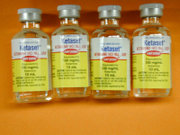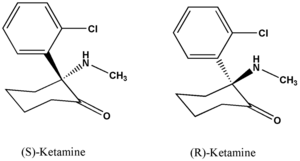Ketamine
Ketamine is a general dissociative anaesthetic for human and veterinary use. Its hydrochloride salt is sold as Ketanest®, Ketaset®, and Ketalar®. Pharmacologically it is very similar to other dissociative anesthetics such as tiletamine and phencyclidine (PCP). more...
History
Ketamine was first synthesized in 1962 in an attempt to find a safer anaesthetic alternative to PCP, which was more likely to cause hallucinations and seizures. The drug was first used on American soldiers during the Vietnam War, but is often avoided now because it can cause unpleasant out-of-body experiences. It is still used widely in veterinary medicine, and for select human applications.
Ketamine's "unpleasant" side effects prompted its first psychedelic use in 1965. The drug was used in psychiatric and other academic research through the 1970s, culminating in 1978 with the publishing of John Lilly's The Scientist, a book documenting the author's ketamine, LSD, and isolation tank experiments. The incidence of recreational ketamine use increased through the end of the century, especially in the context of raves and other parties. The increase in illicit use prompted ketamine's placement in Schedule III of the United States Controlled Substance Act in August 1999. In the United Kingdom, it became outlawed and labelled a Class C drug on January 1, 2006.
Medical use
Given that it suppresses breathing much less so than most other available anaesthetics, ketamine is still used in human medicine as a first-choice anaesthetic for victims with unknown medical history (e.g. from traffic accidents), in podiatry and other minor surgery, and occasionally for the treatment of migraine. There is ongoing research into the drug's usefulness in pain therapy and for the treatment of alcoholism and heroin addiction.
In veterinary medicine, ketamine is often used for its anaesthetic and analgesic effects on cats, dogs, rabbits, rats, and other small animals. Veterinarians often use ketamine with sedative drugs to produce balanced anaesthesia and analgesia, and as a constant rate infusion to help prevent pain wind-up. Ketamine is used to manage pain among horses and other large animals, though it has less effect on bovines.
Ketamine may be used in small doses (0.1–0.5 mg/kg/hr) as an analgesic, particularly for the treatment of pain associated with movement and neuropathic pain. It has the added benefit of counter-acting spinal sensitization or wind-up phenomena experienced with chronic pain. At these doses, the psychotropic side effects are less apparent and well managed with benzodiazepines. Ketamine is a co-analgesic, requiring a concomitant low-dose opioid to be effective.
The effect of Ketamine as a depressant on the respiratory and circulatory systems is less than that of other anaesthetics. When used at anaesthetic doses, it will sometimes stimulate rather than depress the circulatory system. It is sometimes possible to perform ketamine anaesthesia without protective measures to the airways. Ketamine is also a potent analgesic and can be used in sub-anaesthetic doses to relieve acute pain; however, its psychotropic properties must be taken into account. Patients have reported going into other worlds or seeing God while anaesthetized, and these unwanted psychological side-effects have marginalized the use of ketamine in human medicine.
Read more at Wikipedia.org




